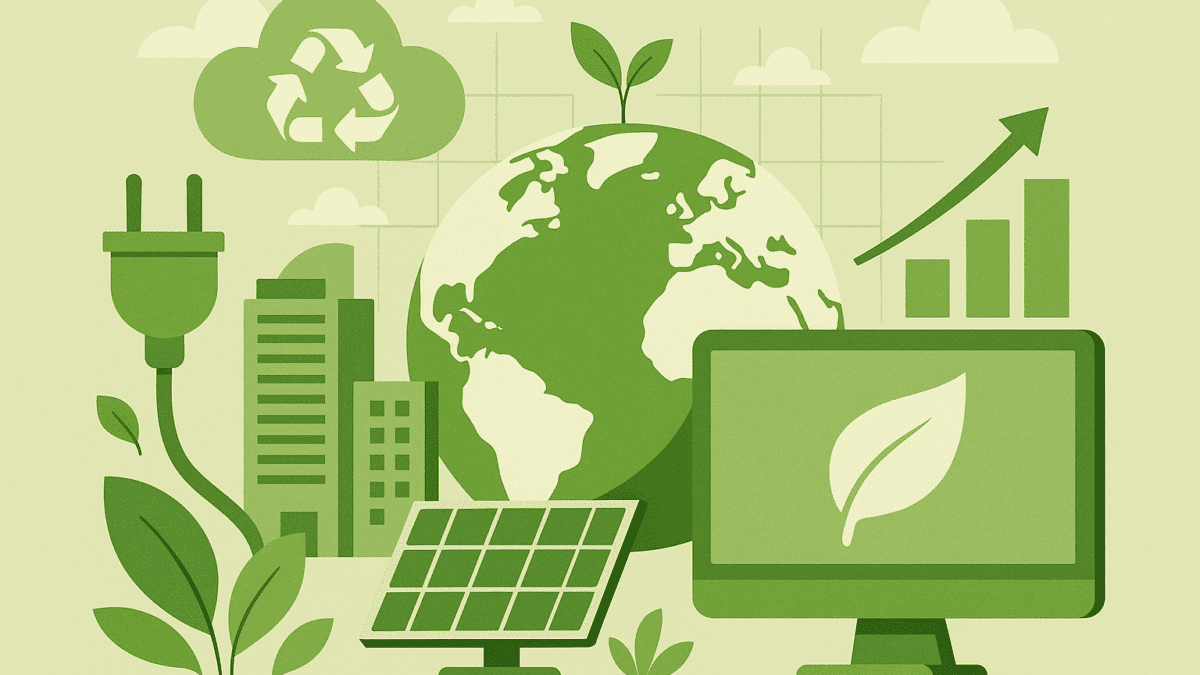Green IT Revolution: How Sustainable Tech is Shaping Business Strategy
Sustainability is no longer an optional add-on for businesses—it’s a strategic priority. The Green IT revolution is reshaping how companies use technology to balance growth with environmental responsibility.
From reducing carbon footprints to adopting energy-efficient cloud services, businesses are rethinking IT infrastructure in ways that align with ESG goals and long-term competitiveness.
This article explores the drivers behind Green IT, real-world applications across industries, and strategies businesses can adopt to future-proof operations with sustainable technology.
What Is Green IT?
Green IT (Green Information Technology) refers to designing, using, and managing technology in environmentally sustainable ways.
Core principles include:
- Reducing carbon emissions from data centers and hardware
- Minimizing e-waste through recycling and circular economy practices
- Optimizing energy consumption with smart systems
- Promoting cloud-based, paperless workflows
Example: Migrating to cloud servers powered by renewable energy can cut IT emissions dramatically.
Why Businesses Are Embracing Sustainable Tech
The Green IT revolution is gaining momentum due to economic, social, and regulatory pressures.
Key drivers include:
- Cost Savings: Energy-efficient systems lower operating expenses.
- ESG Reporting: Investors demand sustainability metrics.
- Regulatory Compliance: Governments push stricter carbon emission rules.
- Customer Expectations: Consumers prefer eco-conscious brands.
According to Accenture, companies that embed sustainability into operations could see 20% higher revenues compared to those that don’t.
Green IT in Action: Real-World Applications
1. Data Centers
Traditional data centers consume enormous amounts of electricity. Green IT promotes low-carbon cloud solutions and liquid cooling systems to cut energy use.
2. Hardware Lifecycle Management
Companies adopt circular IT models where devices are refurbished, reused, or recycled instead of discarded.
3. Cloud & Virtualization
By shifting to shared cloud infrastructure, businesses reduce the need for on-premises servers, cutting energy and costs.
4. Smart Workplaces
IoT sensors and AI-powered systems manage lighting, heating, and power, ensuring energy efficiency.
5. Sustainable Software Development
Coding practices that minimize processing power help reduce energy demand over time.
Example: Microsoft pledged to be carbon negative by 2030, with investments in carbon removal and green data centers.
Benefits of Adopting Green IT
Businesses implementing sustainable tech strategies enjoy:
- Lower Costs – Energy savings from efficient infrastructure.
- Brand Reputation – Green initiatives improve customer trust.
- Regulatory Advantage – Stay ahead of global compliance standards.
- Innovation Boost – Drive new eco-friendly products and services.
- Talent Attraction – Younger employees prefer sustainable employers.
Challenges in the Green IT Journey
Despite benefits, Green IT adoption faces hurdles:
- High Upfront Costs: Sustainable hardware and systems require investment.
- Complex Transitions: Migrating IT infrastructure to eco-friendly models is resource-intensive.
- Measuring Impact: Quantifying sustainability improvements can be difficult.
- Resistance to Change: Employees and leadership may be slow to adapt.
Example: Smaller businesses often struggle with capital-intensive green upgrades despite long-term benefits.
Step-by-Step Guide: How Businesses Can Embrace Green IT
- Audit IT Infrastructure – Measure current energy use and carbon footprint.
- Set Clear Goals – Align IT sustainability targets with ESG strategy.
- Adopt Cloud & Virtualization – Reduce on-premises IT energy consumption.
- Choose Green Vendors – Partner with suppliers who use renewable energy.
- Optimize Hardware Lifecycle – Extend device life through recycling and refurbishment.
- Educate Employees – Promote energy-conscious behaviors at work.
- Monitor & Report Progress – Track emissions, costs, and ROI of green initiatives.
Case Studies: Businesses Leading the Green IT Revolution
- Google: Runs data centers on 100% renewable energy and invests in AI-driven cooling systems.
- Apple: Commits to a net-zero supply chain by 2030 and uses recycled materials in devices.
- HP: Extends hardware lifecycle with take-back programs and sustainable printing initiatives.
These leaders show how sustainable IT strategies not only reduce environmental impact but also strengthen business resilience.
The Future of Sustainable Tech in Business Strategy
By 2030, businesses that fail to adopt Green IT practices risk falling behind competitors who reduce costs, comply with regulations, and attract eco-conscious customers.
The future will see:
- AI-driven energy optimization across IT infrastructure
- Carbon-neutral supply chains supported by blockchain transparency
- Global standards mandating sustainability metrics for IT systems
Green IT is no longer just an environmental initiative—it’s becoming a core pillar of business strategy.
Conclusion
The Green IT revolution is reshaping business strategy worldwide. From energy-efficient data centers to sustainable supply chains, companies that embrace green technology gain cost advantages, stronger reputations, and future-ready operations.
Ready to align your business with sustainable growth? Explore our B2B Lead Generation Services and discover eco-conscious strategies that drive results.





